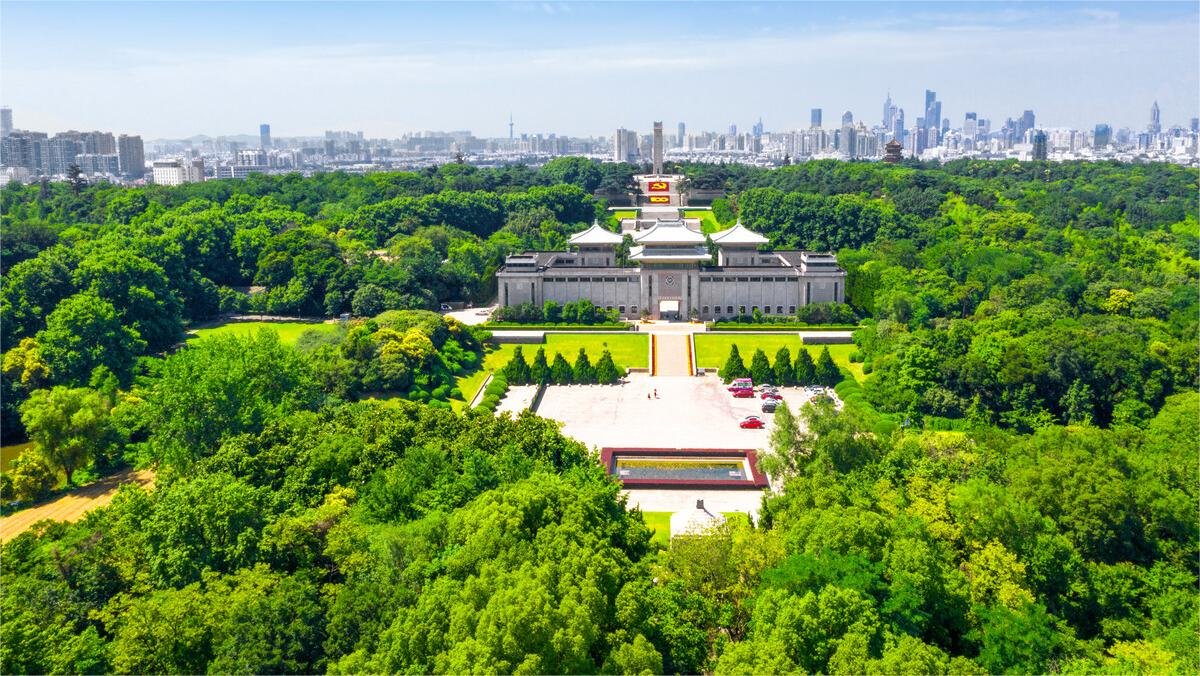Yuhuatai Scenic Area (雨花台风景区), located in the northern part of Yuhuatai District in Nanjing, China, spans an expansive 1.537 million square meters. It holds a special place in Chinese history as a sacred memorial to the New Democratic Revolution and stands as the largest commemorative mausoleum in New China. This site combines education, tourism, leisure, and entertainment, making it a prominent provincial-level scenic area in Jiangsu. It comprises six major functional zones: Historical and Scenic Zone, Martyrs’ Cemetery Zone, Yuhuatai Stone Culture Zone, Yuhuatai Tea Culture Zone, Recreational Zone, and the Ecological Forest Zone.
With a history dating back over 3,000 years, Yuhuatai has witnessed the passage of time and numerous historical events. Its significance dates back to the year 1147 BC when the Tai Bo clan settled in this region and passed on agricultural knowledge. From 472 BC, when King Goujian of Yue built “Yuecheng” in the area, Yuhuatai became a popular destination for enjoying panoramic views of Jiangnan. During the Three Kingdoms period, the region was known for its colorful stones, earning it names like Shizigang (Stone Hill), Manao Hill, and Jubao Hill. In the Southern Dynasty during the reign of Emperor Wu of Liang, Buddhism was flourishing, and the renowned monk Master Yunguang established a preaching altar on Yuhuatai. It is said that his teachings moved the heavens, leading to petals falling like rain, and thus, the name Yuhuatai was born.
Table of Contents
- Basic Information
- Location and Transportation
- Highlights of Yuhuatai Scenic Area
- Vlog about Yuhuatai Scenic Area
- Other Natural Sceneries in Nanjing
Basic Information
| Website | http://www.travel-yuhuatai.com/ |
| Estimated Length of Tour | About 2 hours |
| Ticket Price | Admission to the park: Free Yuhua Stone Cultural Area: 10 RMB Yuhua pavilion: 7 RMB |
| Opening Hours | 8.00 – 17.00 |
| Telephone Number | 0086-025-52411523 |
Location and Transportation
Yuhuatai Scenic Area is located in the southern part of Nanjing, the capital city of Jiangsu Province in eastern China. It covers an area of about 32 square kilometers and is easily accessible by public transport. To get there, you can choose the following ways:
Bus: Take bus 26, 304, or 764 and get off at Yuhuatai East Gate Stop (雨花台东大门).
Metro: The nearest metro station to Yuhuatai Scenic Area is Yuhua Gate (雨花门) on line 3. After getting out of the station, walk about 1.5 kilometers to the east to reach the area.
Highlights of Yuhuatai Scenic Area
Yuhuatai Martyrs’ Cemetery
The Yuhuatai Martyrs’ Cemetery is situated on the hilly terrain of Yuhuatai in Nanjing, forming a prominent memorial mausoleum and the largest of its kind in New China. The cemetery includes five main hills, with the central peak serving as the axis, running from south to north. Key features within the cemetery include the South Gate, a spacious plaza, a memorial hall, a commemorative bridge, a monument to revolutionary martyrs, a large statue of martyrs at the North Sacrifice Site, the North Gate, and a group of martyrs’ graves at the West and East Sacrifice Sites, along with a commemorative pavilion, to name a few. This cemetery pays homage to the countless heroes who sacrificed their lives for the cause of the New Democratic Revolution.
Jiangnan Second Spring
Originally known as Yuhua Spring, the Jiangnan Second Spring is characterized by two spring openings, with water emerging just one meter below the surface. The famous Southern Song Dynasty poet Lu You, during his tenure in Sichuan, passed through Jiankang (the ancient name for Nanjing) and ascended Yuhuatai, where he used the spring water to brew tea. He was greatly impressed and dubbed it the “Second Spring.” The phrase “Jiangnan Second Spring” on marble you can seen now was inscribed by the contemporary renowned calligrapher Xiao Xian.
Muxiyuan (Osmanthus Garden)
Muxiyuan, a garden that mainly features osmanthus trees (also known as sweet olive), with wild azaleas (Rhododendron simsii) complementing the scenery, is a tranquil and scenic area covering an area of 12 acres. Established in 1999, Muxiyuan consists of various sections, including the Osmanthus Specialty Garden, an artificial hill with waterfalls, a pavilion, a wooden pavilion, a curved bridge, and winding paths. The Osmanthus Specialty Garden boasts 26 different varieties of osmanthus, with thousands of trees, while the lakeside embankment is adorned with an impressive eight-meter-tall group of artificial hills and waterfalls that cascade southward.
Plum General Hill and Corridor
In the early Eastern Jin Dynasty, as Hu invaders pressed further south, the capital was relocated, and General Mei Ze led troops to resist the invaders, stationing his troops on a hill. To commemorate General Mei Ze’s bravery and dedication, a temple was built there, and plum trees were extensively planted, giving rise to the name “Meigang” (Plum General Hill). By the Ming and Qing Dynasties, the area had become a thriving plum blossom garden, alongside Meilin (Plum Grove) at the foot of Zhongshan Hill, forming two major plum blossom viewing spots of Nanjing. In 1999, Yuhuatai Scenic Area reconstructed Meigang, comprising “Fangmei Pavilion,” “Wenmei Pavilion,” “Hanxiang Pavilion,” and “Qu Corridor.”








Rain Flower Terrace Tour Route: Yuhua West Road ➡️ Nengrenli Market ➡️ Communist Youth League Road ➡️ Beimen (North Gate) ➡️ Meilang ➡️ Rain Flower Pavilion ➡️ Martyrs Cemetery ➡️ Amusement Park 1⃣️ Nengrenli Market: Similar to the atmosphere of Confucius Temple’s 378 Alley, bustling with activity. Start your half-day itinerary with a serving of Wuzheng Rice in the morning. 2⃣️ Wang’s Wanton on the northeast side of Beimen: Not too large in size, served with shrimp, spicy oil, and… Read more »